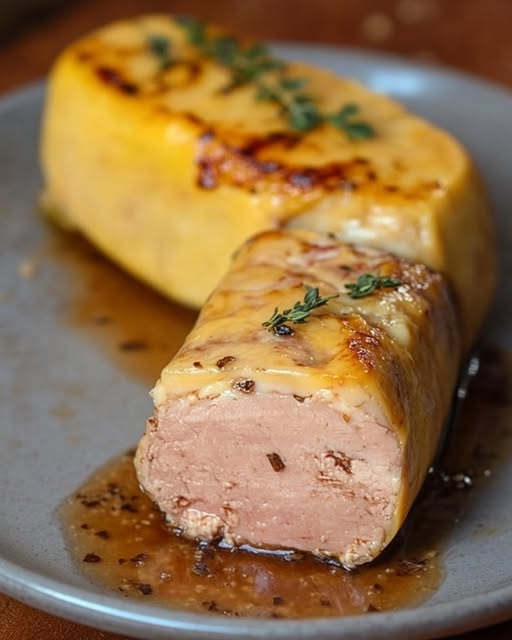A Taste of France: Wrapped Duck Liver Made Easy
There’s something magical about the first bite of a perfectly prepared **Wrapped Duck Liver**. Creamy, rich, and utterly indulgent, this French delicacy has a way of turning any meal into a celebration. I remember the first time I made it for my family during the holidays. The kitchen smelled like cognac and Christmas magic as I unwrapped the torchon to reveal a beautifully smooth terrine. Everyone was amazed that something so luxurious could come from such simple steps. Today, I’m sharing my foolproof recipe for **Foie Gras au Torchon**, along with tips to make it shine at your next gathering.
From French Roots to Your Table
The tradition of preparing foie gras dates back centuries in France, where it became a symbol of fine dining and culinary excellence. Historically, chefs would use fresh duck or goose livers to create decadent dishes fit for royalty. While modern techniques have evolved, the **torchon method** remains one of the most beloved ways to prepare foie gras. Why? It’s all about simplicity. Wrapping the liver in a clean cloth (or torchon) not only shapes it but also ensures even cooking and infuses it with flavor. This technique has stood the test of time because it delivers consistent results without fancy equipment.
Why You’ll Love This Recipe
If you’ve ever thought making foie gras sounds intimidating, let me assure you—this recipe is different. With just a handful of ingredients and straightforward steps, you can create a dish that feels gourmet but doesn’t require hours in the kitchen. The combination of salt, pepper, sugar, and cognac enhances the natural richness of the duck liver while keeping things balanced. Plus, serving this dish will instantly elevate your hosting game. Imagine slicing into velvety layers of **Wrapped Duck Liver** and pairing it with crusty bread or sweet fig jam. Pure bliss!
Perfect Occasions to Serve This Dish
This recipe shines brightest during special occasions. Whether it’s a holiday feast, an anniversary dinner, or a cozy evening with friends, **Foie Gras au Torchon** adds a touch of elegance. I love serving it on New Year’s Eve alongside sparkling wine—it’s festive, impressive, and always a crowd-pleaser. But don’t save it only for big events; sometimes, life calls for treating yourself to something extraordinary, even if it’s just a quiet night in.
Ingredients You’ll Need
- 1 raw duck liver (500g)
- 10g of salt
- 2g of black pepper
- 2g of sugar
- 5cl of cognac or Armagnac
- 1 clean cloth (torchon)
Substitution Options
Not everyone has access to every ingredient, and that’s okay! If you can’t find Armagnac, feel free to substitute it with brandy or another high-quality spirit. For those who prefer less alcohol, a splash of orange juice mixed with zest works well too. As for seasonings, smoked paprika or crushed pink peppercorns can add a unique twist if you’re feeling adventurous.
Step 1: Preparing the Duck Liver
Start by carefully deveining the duck liver. This step might sound tricky, but take your time—it’s worth it. Use a small knife to gently remove any veins without tearing the delicate flesh. Once cleaned, let the liver sit at room temperature for about 20 minutes. This helps it absorb flavors better later. Pro tip: Keep the workspace cold to prevent the liver from becoming too soft.
Step 2: Seasoning the Liver
In a small bowl, mix the salt, black pepper, and sugar. Sprinkle this seasoning blend evenly over the liver, making sure every nook and cranny gets coated. Next, drizzle the cognac or Armagnac over the top. The aroma alone will transport you straight to the French countryside! Massage the mixture lightly into the liver to ensure even distribution.
Step 3: Wrapping the Torchon
Now comes the fun part—wrapping! Lay out your clean cloth on a flat surface and place the seasoned liver in the center. Roll it tightly into a sausage shape, ensuring there are no air pockets. Secure the ends with kitchen twine. Chef’s tip: Tie the string snugly but not too tight, or the liver may lose its shape during cooking.
Step 4: Cooking the Torchon
Fill a large pot with water and bring it to a gentle simmer—not boiling, just bubbling slightly. Submerge the wrapped liver and cook for exactly 15 minutes. Keep an eye on the water temperature; consistency is key here. Afterward, remove the torchon and let it cool completely before refrigerating. Patience pays off—the resting period allows the flavors to meld beautifully.
Timing Breakdown
– Prep Time: 30 minutes
– Cook Time: 15 minutes
– Resting Time: 24 hours
– Total Time: Approximately 25 hours
While waiting might feel excruciating, trust me, the result is worth it. Each slice will be silky smooth and bursting with flavor.
Chef’s Secret
For an extra layer of depth, toast the spices lightly before mixing them with the liver. Heating releases their essential oils, intensifying the aroma and taste. It’s a small step that makes a big difference.
An Interesting Fact About Foie Gras
Did you know that foie gras literally means “fat liver” in French? Ducks and geese naturally store fat in their livers before migration, which inspired humans to replicate this process through controlled feeding. While controversial, ethical sourcing is becoming more common, allowing food lovers to enjoy this delicacy responsibly.
Necessary Equipment
You won’t need much to prepare this dish—a sharp knife, a clean cloth, kitchen twine, and a large pot are essentials. A thermometer can help monitor water temperature, but it’s optional if you’re confident in gauging a simmer.
Storage Tips
Once prepared, **Wrapped Duck Liver** keeps well in the fridge for up to a week. Store it wrapped in its cloth inside an airtight container to preserve moisture. For longer storage, freeze portions individually in parchment paper. Thaw overnight in the fridge before serving.
Leftovers? No problem! Thin slices can be frozen and enjoyed later. Just thaw them slowly to maintain texture. Never refreeze after thawing, though, as this compromises quality.
Finally, always handle foie gras with care. Its delicate nature means rough handling can ruin its creamy consistency. Treat it like gold, and it will reward you generously.
Tips and Advice
To enhance the dish, serve it with accompaniments like toasted brioche, apple chutney, or pickled onions. These contrasting flavors balance the richness of the liver beautifully. Another pro tip: Slice the foie gras thinly using a warm knife for clean cuts.
If you’re new to deveining, watch a tutorial online—it’s easier than you think. And remember, practice makes perfect. Don’t worry if your first attempt isn’t flawless; each try brings you closer to mastery.
Presentation Ideas
Presentation matters! Arrange thin slices of foie gras on a slate board with edible flowers for a pop of color. Drizzle a bit of honey or balsamic glaze around the edges for added flair. Garnish with fresh herbs like thyme or rosemary for a rustic touch.
For a modern look, stack slices vertically in a glass jar layered with fruit compote. Guests will rave about both the taste and the visual appeal.
Healthier Alternatives
While traditional **Foie Gras au Torchon** is indulgent, there are lighter versions you can try:
1. **Chicken Liver Pâté**: Swap duck liver for chicken liver for a leaner option. Add cream and butter for smoothness.
2. **Vegetarian Terrine**: Use mushrooms and nuts blended with herbs and spices for a plant-based alternative.
3. **Low-Sodium Version**: Reduce the amount of salt and increase herbs for flavor.
4. **Herb-Crusted Foie Gras**: Coat the torchon in breadcrumbs mixed with dried herbs for added texture.
5. **Citrus-Infused Foie Gras**: Replace cognac with lemon juice and zest for a refreshing twist.
6. **Spiced Foie Gras**: Experiment with exotic spices like cinnamon or star anise for a unique profile.
Common Mistakes to Avoid
Mistake 1: Skipping the Deveining Step
Deveining is crucial for achieving a smooth texture. Neglecting this step leaves chewy bits that ruin the experience. Take your time and work carefully. Pro tip: Chill the liver briefly beforehand—it firms up and makes deveining easier.
Mistake 2: Overcooking the Torchon
Overcooking turns foie gras grainy instead of silky. Stick to the recommended 15-minute simmer and avoid boiling water. A timer is your best friend here.
Mistake 3: Rushing the Resting Period
Skipping the 24-hour rest deprives the flavors of time to develop fully. Plan ahead and resist the urge to cut into it early. Trust me, patience is rewarded.
FAQ
What is the best way to serve foie gras?
Foie gras pairs wonderfully with sweet and tangy accompaniments. Try it with fig jam, caramelized apples, or pickled onions for contrast. Serve thinly sliced on warm toast for a melt-in-your-mouth experience.
Can I use goose liver instead of duck liver?
Absolutely! Goose liver tends to be larger and slightly milder in flavor, but the preparation method remains the same. Adjust seasoning accordingly based on personal preference.
Is foie gras unhealthy?
Like many rich foods, moderation is key. Foie gras is high in fat and calories, but occasional indulgence won’t hurt. Pair it with lighter sides to balance the meal.
How do I choose ethically sourced foie gras?
Look for labels indicating humane farming practices. Some producers prioritize animal welfare and transparency. Research brands committed to sustainable methods.
Can I freeze foie gras?
Yes, foie gras freezes well. Wrap individual portions in parchment paper and store in a freezer-safe bag. Thaw slowly in the fridge before serving.
What alcohol pairs best with foie gras?
Sweet wines like Sauternes or Port complement the richness of foie gras beautifully. Sparkling wines and dry champagnes also work wonders.
Why does my foie gras taste bitter?
Bitterness often stems from burnt spices or improper seasoning ratios. Toast spices gently and measure carefully. Balance sweetness with sugar or honey if needed.
How long does foie gras last in the fridge?
Properly stored, foie gras lasts up to a week. Keep it wrapped tightly to prevent drying out. Always check for off smells before consuming.
Can I make foie gras without alcohol?
Yes, replace alcohol with citrus juice or fruit puree for moisture and flavor. Orange or apple works particularly well.
What tools do I need to prepare foie gras?
Basic tools include a sharp knife, a clean cloth, kitchen twine, and a large pot. Optional items are a thermometer and a zester for garnishes.
A Final Word on Wrapped Duck Liver
Creating **Foie Gras au Torchon** is a rewarding experience that brings people together. Whether you’re celebrating a milestone or simply enjoying good company, this dish never fails to impress. With these tips and tricks, you’re ready to master the art of wrapping duck liver. So roll up your sleeves, pour yourself a glass of wine, and get cooking—you’ve got this!

Wrapped Duck Liver
Ingredients
Equipment
Method
- Carefully devein the duck liver using a small knife.
- Let the liver sit at room temperature for about 20 minutes.
- In a small bowl, mix the salt, black pepper, and sugar.
- Sprinkle the seasoning blend evenly over the liver.
- Drizzle the cognac or Armagnac over the liver and massage it in.
- Lay the clean cloth out flat and place the seasoned liver in the center.
- Roll the cloth tightly into a sausage shape and secure the ends with kitchen twine.
- Fill a large pot with water and bring it to a gentle simmer.
- Submerge the wrapped liver in the water and cook for exactly 15 minutes.
- Remove the torchon from the pot and let it cool completely before refrigerating.
